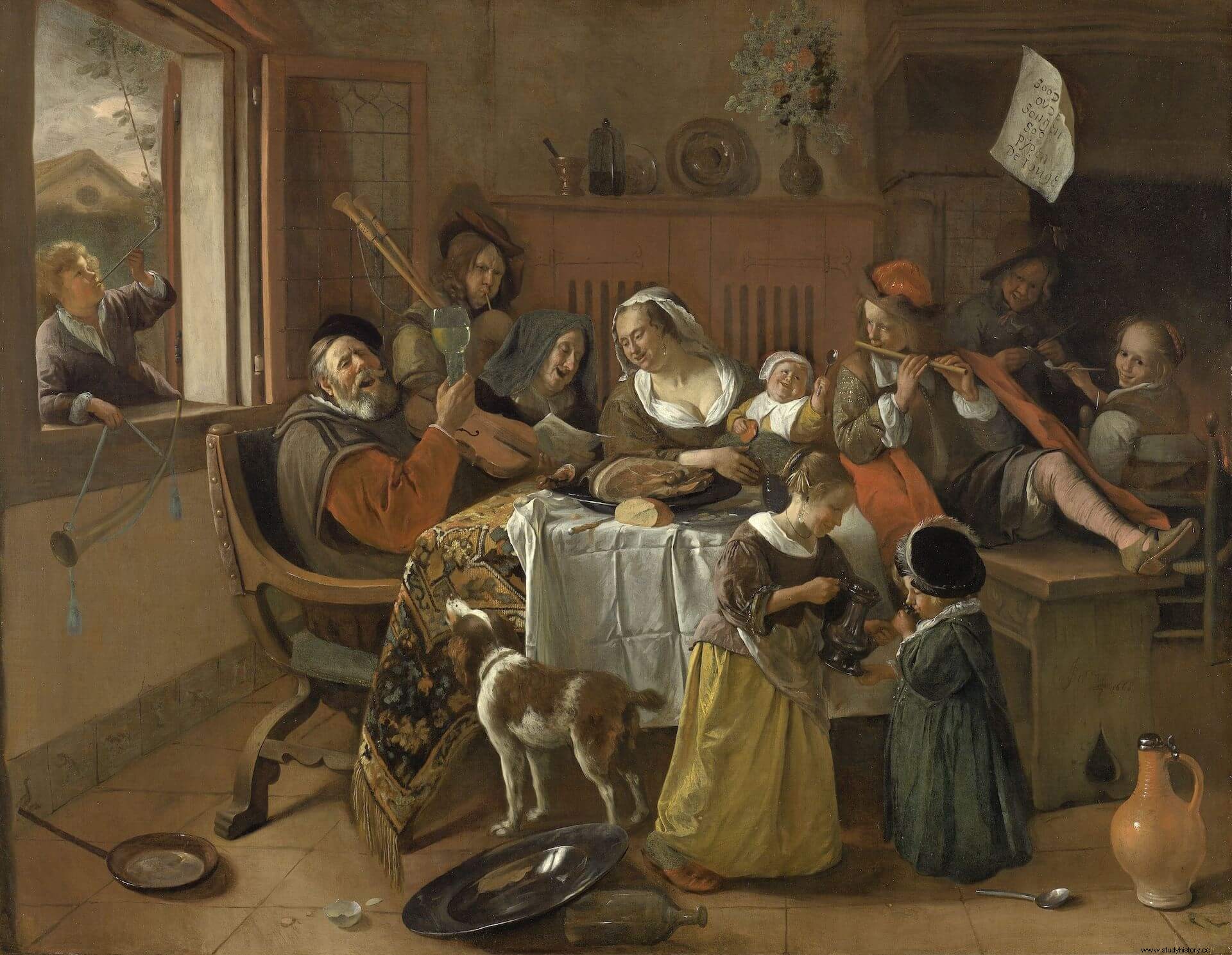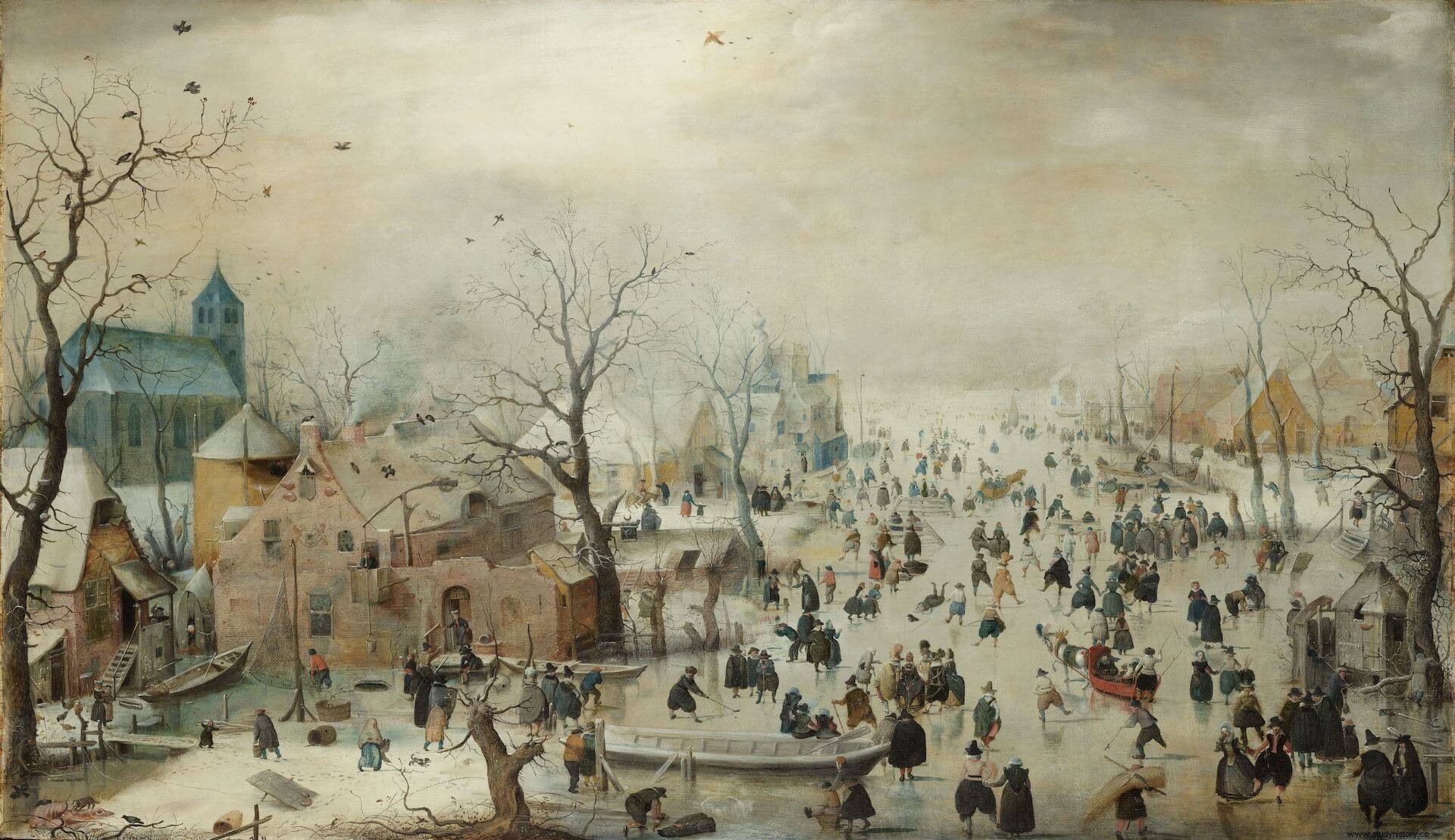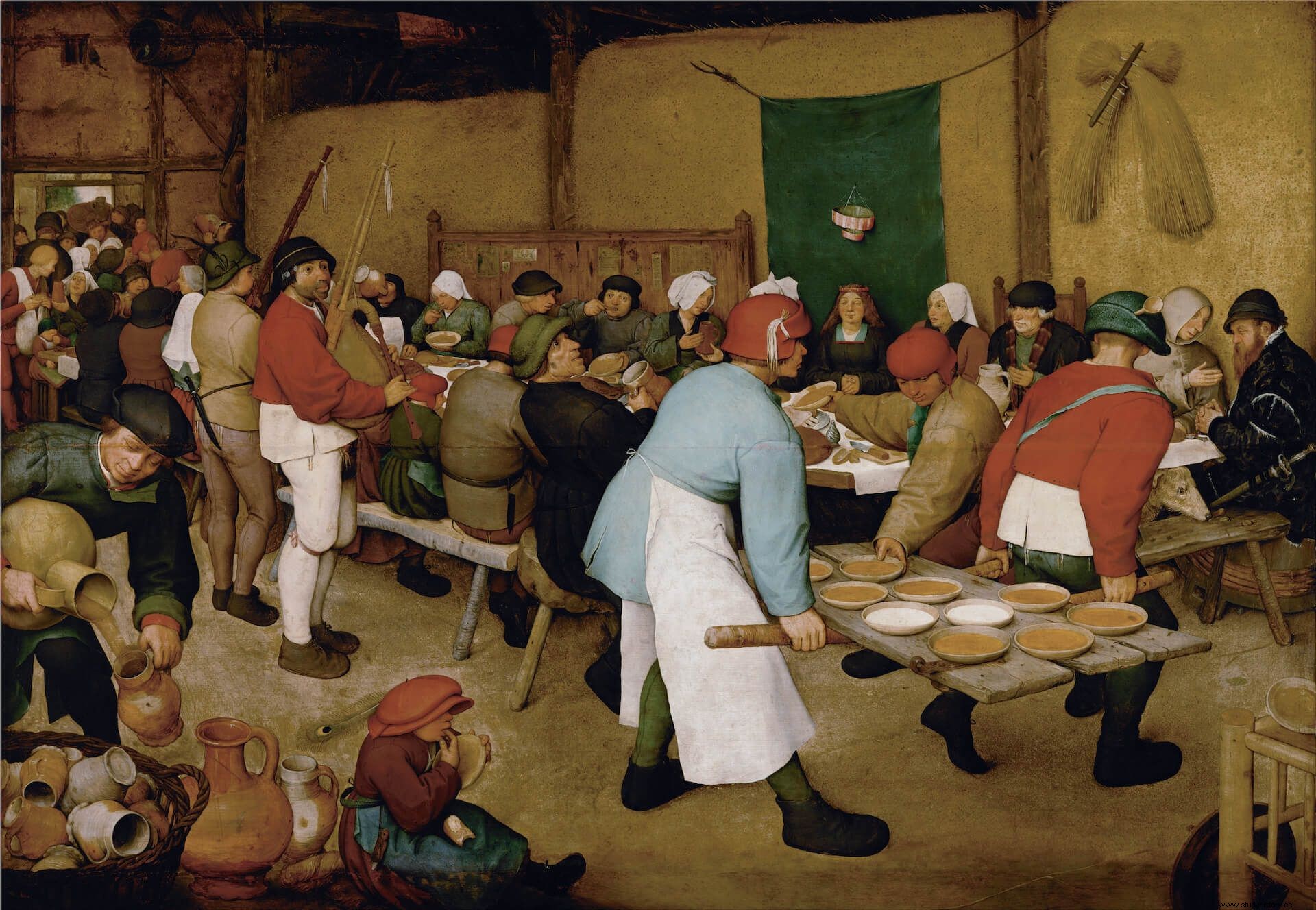
The soldiers of the Duke of Alba burst into the world embodied on canvas by Pieter Brueghel the Elder in pictures that are partly humorous –without a certain air of social criticism– and partly bucolic, such as La boda campesina (1568), The Flemish proverbs (1559) and The wine of the feast of Saint Martin (c.1565-1568). Leaving behind the Alpine gorges, Franche-Comté and Lorraine, the Spanish veterans of Italy, many of whom had participated in the relief of Malta against the Ottomans in 1565, plunged into the Flanders of the kermesses and the ommegangs , of the saraos and the carnivals, the life of whose inhabitants was a real battle between Don Carnal and Doña Cuaresma, to cite another recurring pictorial motif of Dutch art. Soon the Spanish soldiers developed their particular vision of the nature of the natives of the Netherlands, their lifestyle and their celebrations, and came to blend into the landscape by actively participating in the festivities and local life, even getting married. with flamenco women and putting down roots in the country.
Flamingos and beer
Since his retirement from Jaen, the captain and sergeant major Alonso Vázquez wrote a delicious chronicle in which, in addition to battles, sieges and jackets, he collected the way of being and the customs of the flamingos , whom he reflects as honest, industrious men and women, seasoned merchants and lovers of letters; perhaps too much, because “since there is no Inquisition or whoever is at hand, they let themselves be carried away by the delicious entertainment of reading, and easily fall into great errors due to the many heretical and depraved writings that are published from the surrounding kingdoms and provinces. They are printed." A similar opinion was expressed by Captain Diego de Villalobos y Benavides, who censured them in the following terms:"They are so full of errors, that together all the heresies of the world are found in them, having in some cities of the rebels as many sects as there are children, servants and parents”.
The greatest vice that Vázquez imputed to the inhabitants of the Netherlands, however, was his fondness for drunkenness , which he did not hesitate to point out as the root of his unruly character. The Spaniard blamed the Flemish for it, but not without a certain well-intentioned hilarity on his part. The captain says that the countrymen of the region,

Among the curiosities that Vázquez noted with an anthropological perspective on the relationship of flamencos with drink, it is worth mentioning the practice that their judges had of “each one drinking a glass of white wine on an empty stomach; They say that they do it to open understandings and to have better judgment”, or the fact that they made wooden jugs that they filled with beer or wine and with which they gave their children a drink during the breastfeeding period.
Vázquez was not the only Spaniard who was surprised by the Flemish attachment to beer . Pedro Cornejo, one of the first chroniclers of the war, wrote that the natives of the Netherlands showed great appreciation for a “water cooked with certain materials that due to its strength drinking it too drunk, which is called cerveça, and this is considered better the one that before does that effect”. Captain Villalobos y Benavides mentions that during the siege of Doullens (1595), in the north of France, several Walloon soldiers of the Spanish army, who were working in the trenches, were rewarded with a boot of beer and that, while quenching their thirst , a cannon shot hit them and killed seven; "And I believe that those who were left alive were more hurt to see their beer spilled than their dead comrades."
Another aspect that Alonso Vázquez criticized of the way of being of the natives of the Netherlands is their credulity and their tendency to superstition, which were not limited to the peasants, but that also reached the upper echelons, and of which he gives the following example:
An unusual landscape:dikes, locks and dunes
The Netherlands couldn't be more different from temperate and sunny Spain in terms of landscape, which caught the attention of the Hispanic soldiers who fought there. The northern provinces, located in the Rhine-Meuse delta, were located on flat land, below sea level, and required strong dikes to prevent the floodwaters from inundating the countryside. Vázquez describes these formidable works of engineering as "paths made by hand with a lot of earth, stakes and fajina to stop the waters from coming together", and he says that the Dutch "walk on them from one part to another in cars and as they see fit". Another engineering work characteristic of the region was the locks, “which are large gates made of boards and wood that stop the waters, and with an ingenious artifice they raise them and, if they think so, flood the land. In this way they have the water dammed and detained in these locks to use it in the navillos [canals] where they need it, whenever it is offered to them.”
The strong currents, the winds and the low elevation of the land had configured a landscape of dunes along the entire coast of the Netherlands. The military and diplomat Bernardino de Mendoza described this geographical feature in detail:

The real mountains, on the other hand, were practically nonexistent, with the exception of the grayish steep hills that characterized the landscape of Luxembourg, Namur, Hainaut and the bishopric of Liege, along the Meuse. These rock formations were famous throughout Europe thanks to the canvases of an artist from the region, Joachim Patinir (ca. 1480-1524), highly valued by Philip II and who had led to the birth of Nordic landscape painting.
The southern provinces, unlike the northern ones, were fertile and forested. The most populated cities were concentrated there, large commercial emporiums embellished by cathedrals, churches, monasteries, hospices, castles, palaces and sumptuous homes. Vázquez was full of praise for the cities of the county of Flanders, among the richest in Europe:
On the other hand, the Spanish soldiers missed the great variety of fruits and vegetables in their homes, because in Flanders, as Vázquez said, although it was very fertile in grains and its cattle were excellent,
All this, however, could be purchased at a moderate price in the markets of the great Flemish towns, where amenities abounded.
Flanders, the country of Cockagne
For Spanish and Italian soldiers, when far from muddy trenches, mist-shrouded dikes and treacherous dunes, Flanders could become a paradise . Vázquez says that its harsh climate made the wines imported from Spain excellent, since “the coldness purifies and seasons them much better than where they are raised” – the soldiers could also buy aloque and claret from the Moselle vineyards, “which are excellent and very kind." The description made by the Jaen native of the Duchy of Brabant evokes a true country of the Cockaigne at the antipodes of the mudflats that the flooded trenches became:
In the Netherlands, in addition to excellent wine, sumptuous churches and country houses that are pleasing to the eye, the Spanish came across unprecedented oddities in their homes such as the stoves, sleds and skates , which expanded their forms of entertainment. Some private houses had their own stoves, but there were also public bathrooms with this amenity, and according to Vázquez:
Regarding the skates, the humanist Antonio de Torquemada described them as “flat irons with points at the front [...] and with these they slide on the ice so that in a short time They go a long way." In winter, when the urban canals froze, the bourgeois would go out skating dressed in their best clothes, as the canvases of painters such as Hendrick Avercamp show.

Vázquez elaborates on the amenities that awaited the soldiers with overflowing pockets, like the inns, "which are private houses where they give food splendidly and with great cleanliness, for moderate interest, to all foreigners with a lot of gifts"; or the brothels of Antwerp , the famous macarelajes, which offered clients oil portraits of the prostitutes, so that they "chose the ones they liked, and then the master of the house went and brought him the original, and having enjoyed it, he sent for wine or beer". Many young Flemish women, poor but seasoned, moved alone from the countryside to the great Brabantine emporium to gather their marriage dowry in the mackerels. In the comedy The assault on Maastricht (ca. 1600-1606), Lope de Vega includes a female character who seems to have come from such an environment, the young Flemish woman Aynora, who exclaims at a certain point:
The combination of rich soldiers with free time was very beneficial for the local population – although, in the long run, not so much for the former. In the summer months of 1589, since Alejandro Farnese was ill, the troops remained unoccupied. The third of the field master Sancho Martínez de Leyva, housed in Lier, began to organize parties; the same was done by the third of Juan Manrique de Lara, who was staying in Malinas. The salary and the savings of the troops vanished in dresses and finery acquired from Flemish merchants. The celebrations were spectacular. The soldiers of the third had long ago earned the nickname of "galanes" and they were honored to keep it. In addition to courting the local maidens, they organized games and carousels in which even horsemen dressed as Moors took part. An improvised castle was built in the main square of the city and the soldiers simulated a siege for the amusement of the local population and the neighbors of the nearby places. Bullfights were even held, "although in Flanders they are very meek and do not get used to running," according to Alonso Vázquez.
The main local festivities, the ommegang –“carnivals”– of Antwerp and Brussels , as well as the parrot festival in the latter city and in Ghent, were no less fun and showy. In the former, the guilds of both metropolises held a parade of impressive floats attended by the cream of the nobility and the mercantile bourgeoisie, and in which the urban militias also marched with their flags and their best clothes. Famous are the paintings by Denis van Alsloot on the ommegang held in Brussels on May 31, 1615 in the presence of the Archdukes Albert and Elizabeth, in which there is no lack of a boat-shaped float. In other paintings of the time we see constructions in the shape of a fish, an elephant or a crowned giant.

The parrot festival consisted of a massive act, also carried out by the militias of the guilds, in which a pike with a wooden parrot on the moharra was raised on top of a mast so that the bourgeoisie would try to bring down the figure with their harquebuses. First the governor and the regidores fired, and, according to Vázquez, "then all the brotherhoods shoot, each soldier by himself, and this must last until one knocks him down and falls to the ground, and having done so, they rejoice and are very happy." with banquets and with so many toasts, which do not stop until they retire to their homes”. To all these celebrations, and also to the more modest kermesses locals, the Spanish soldiers garrisoned in the Flemish villas were invited.
Flemish weddings
The people of the Netherlands were much more welcoming than you might imagine. The heroic kermesse , a 1935 French film, shows how the initial suspicion of the inhabitants of a small Flemish town at the arrival of Spanish troops quickly gives way to cordiality and understanding. The film provoked altercations in some Belgian cities and was accused, due to the political convulsions of the time, of promoting collaborationism.
However, what it reflects does not differ too much from reality, although it is obvious that not everyone felt comfortable. General and Field Master Gonzalo Fernández de Córdoba y Cardona, a descendant of the Great Captain who served under Ambrosio Spínola, wrote to his brother:
Some of the most famous soldiers of the Tercios, on the other hand, married Flemish or Walloon women and put down roots in the Netherlands . Colonel Cristóbal de Mondragón married Guillemette de Chastelet, who defended the castle of Ghent against the rebels in the absence of her husband. Francisco Verdugo, governor of Friesland, had his firstborn with a bourgeois from Haarlem, and later married Dorotea Mansfeld, daughter of one of the leading noblemen of Luxembourg. The most notorious case is that of field master Francisco de Valdés. The legend – famous in its time, but discredited – tells that his lover and later wife, Magdalena Moons, managed to delay the siege of Leiden, which would have saved the city, where she had relatives and friends, from falling into the hands of the Spanish troops.

In Flanders it was easy for a wealthy foreign gentleman to court any woman, regardless of her social background, and make her his wife. Attest to this, in his autobiography, Estebanillo González, "man of good humor", supposedly rogue soldier, buffoon and servant of Cardinal Infante Fernando, as well as General Octavio Piccolomini:
To the misfortune of Estebanillo, as another saying of the time recited –no less true than the one that opens this article–:“There is only one Flanders”.
Fonts
- González, E.; Suárez Figaredo, E. (ed.) (2009):The life and facts of Estebanillo González, a man of good humor composed by himself , in Lemir:Journal of Medieval and Renaissance Spanish Literature , 13, p. 389-632.
- Mendoza, B. de (1592):Comments by don Bernardino de Mendoça on what happened in the wars of the Payses Baxos:from the year 1567 to the year 1577 . Madrid:Pedro Madrigal.
- Vázquez, A. (1879-1880):The Events of Flanders and France in the times of Alexandro Farnese , in Collection of Unpublished Documents for the History of Spain , you 72, 73 and 74. Madrid:Miguel Ginesta.
- Villalobos y Benavides, D. de (1876):Comments on the things that happened in the Low Countries of Flanders from the year 1594 to 1598 . Madrid:Bookstore of the Bibliophiles.
Bibliography
- Collard, P.; Norbert Ubarri, M.; Rodríguez Pérez, Y. (eds.) (2009):Encounters of yesterday and reunions of today:Flanders, the Netherlands and the Hispanic world in the 16th-17th centuries . Gent:Association of Hispanists of the Benelux.
- Thomas, W.; Verdonk, R. A. (eds.) (2000):Encounters in Flanders:Hispano-Flemish relations and exchanges at the beginning of the Modern Age . Leuven:Leuven University Press.
